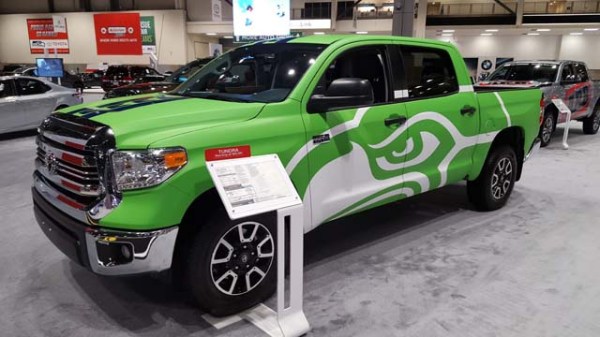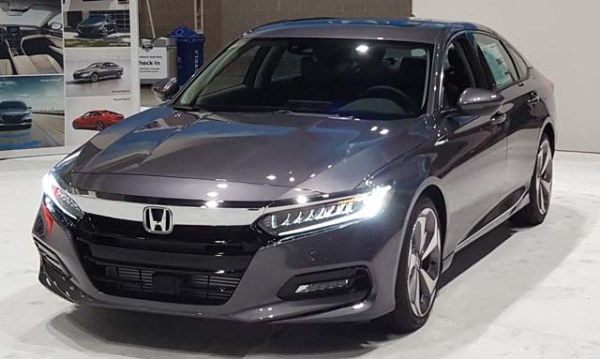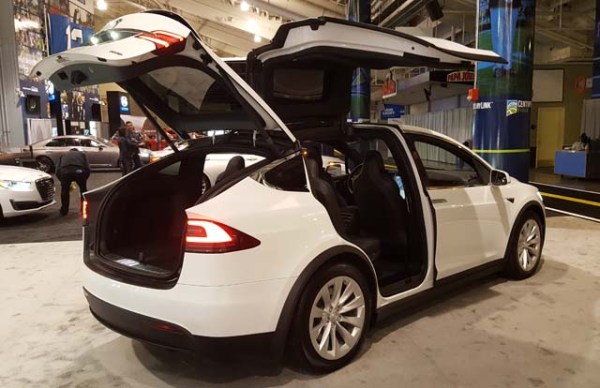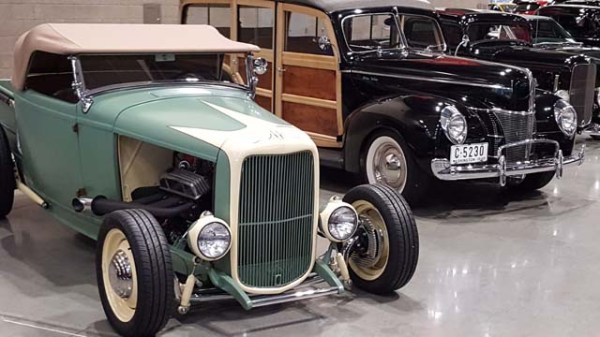2018-Model Seattle Auto Show

Because, reasons. (Orin O’Neill photos, except as noted)
If it’s November, it must be time for me to get off the subject of scooters and do my annual rant about the state of the automotive industry (and incidentally, what happened at the Seattle Auto Show). If you care not for this, you may peruse over 10 years’ worth of scooter awesomeness.
Still here? Auto show story begins after the jump.
The Seattle Auto Show has always had a bit of an identity crisis. Sometimes, it included the calendar year; other times, it was branded with the new model year. This time, all the media materials refer to it as the 2018-Model Seattle International Auto Show. It is now officially Model Year 2018, FWIW.
The thing you’ll notice almost immediately is the increase in white space. By which I mean, fewer cars, and fewer car companies. Mitsubishi (which got swallowed by Nissan earlier this year) was once again absent; there were no hypercars on the Plutocrat Mezzanine, and the main show floor had a lot more elbow room.
This is a trend… car companies are coming to realize big shows (and regional ones like Seattle’s) are not the best way to reach potential customers. In the luxury segment particularly, “experiences” like the one Porsche touted on its video display, seem to be the preferred method for attracting likely Porsche buyers.
President Trump made auto news earlier this week when he posed the question, why don’t the Japanese build cars in the U.S., instead of importing them? Hopefully, you know 75% of the cars sold by Japan-based companies in the U.S. are built in the U.S., Canada, and Mexico (aka, the NAFTA zone). In fact, BMW is a net exporter, sourcing all of its SUVs from its factory in Spartanburg, S.C. for distribution worldwide. The Korean brands have factories in Alabama and Georgia (Hyundai Sonata and Elantra; Kia Sorento), and Mercedes-Benz has been cranking out M-Class SUVs for, like, 20 years in Alabama. The Tweeter-in-Chief really needs to know this.

2018 Honda Civic Type R
When thinking of British cars, the usual suspects come to mind: Jaguar, Land Rover, Rolls-Royce and anything else in the luxe realm. There’s another that may surprise you: the Honda Civic Type R hatchback. Yes. Made in the Swindon, England factory that for a time supplied CR-Vs to North America, it’s the only one you can get with a six-speed manual transmission. Because, Type R. My first new car was a 1980 Honda Civic hatchback (which, oddly enough, is still running around Seattle), and this new one is about as far removed from that tiny econobox as one could possibly get. And just as fugly as the sedan.

2018 Ford Focus
Where in the world is Carmen Sandiego’s Ford Focus? It went from shifting production to a new factory in Mexico, to an existing one elsewhere in Mexico, to… wait for it… CHINA!
In fact, during the transition there will be no Foci built anywhere. And with U.S. sales having dropped like a rock, it’s unlikely anyone will notice.
“We’ve done a lot of research, and consumers care a lot more about the quality and the value than they do about the sourcing location,” said Joe Hinrichs, Ford’s president of global operations, in a conference call with some reporters recently. “iPhones are produced in China, for example, and people don’t really talk about it,” . The Focus will be built in Ford’s plant in Chongquing, and in Germany.
In other Ford news, it wasn’t so many years ago that the Fiesta made a triumphant return to the U.S. market, prompting yr. hmbl. & obdt. servant to proclaim the beginning of a true American B-segment.
Fast-forward to earlier this year: Ford rolled out a new Fiesta in Europe. Slightly larger, more cleanly styled, and the lard-butt sedan has been axed.

2018 Ford Fiesta (photo: Ford Europe)
We in North America won’t be getting it.
Ford’s new-to-North America EcoSport (they tell me, camel-capped, please) occupies the same price point, and is really what people want at the moment, anyway.
In fact, sales of all subcompact hatches are tanking, while their corresponding subcompact crossovers are flying out dealers’ doors. See also: Toyota RAV-4 (best selling new vehicle that’s not a full-size pickup), Nissan Rogue (shoved out of that spot by the RAV-4). Wise people are saying sub-CUVs will be the car market’s new entry point.

2018 Toyota Camry
In a rare alignment of the planets (or product cycles, anyway), both the Honda Accord and Toyota Camry are new for 2018. Both look much less… generic. Both are trying to maintain some relevance as demand for midsize sedans plummets (down almost 20% industry-wide).

2018 Honda Acccord
Apparently, it’s also time for a new 3-Series BMW. The new one arrives in mid-2018 as a 2019 model. It doesn’t look a whole lot different than the current one, for pretty much the same reason a new Accord or Camry didn’t used to: fear of alienating the customer base.

BMW i8 is closer to the idea of an “ultimate” driving machine than a 3-Series
Really, what possible reason could anyone have for buying a 3-Series instead of a Camry or Accord? The midsize twins are engineered, assembled and finished every bit as well as the Bimmer, but either can be bought for many thousands less (even loaded to the hilt), or leased for the same monthly payment, than a base 3-Series.
That “Ultimate Driving Machine” meme was bullshit in the 1970s, and it’s bullshit today. BMW is the Ultimate Designer Label. A label favored by assholes, as so wonderfully illustrated in an Audi commercial where a bro in a BMW drenches a group of people standing at a bus stop. It was always a BMW driver who seemed to think it was necessary to pass me on my scooter with barely three inches to spare, or drive six inches behind my license plate. I don’t want that association any more than the one that comes with riding a Harley.

Genesis G70 (photo: Hyundai)
Which is probably why Hyundai will move a lot of its new-for-2018 Genesis G70s—you won’t see yourself coming and going. (No, there wasn’t one at the Genesis stand. Its official U.S. rollout happens later this month in Los Angeles) Unlike an Alfa-Romeo Giulia, it doesn’t look like a 3-Series Bimmer with a different grille. It ticks pretty much all the BMW’s boxes, and it probably won’t be long at all until you can lease one for the same monthly payment as a Sonata.
OTOH, Buick’s 2018 Regal is, in so many ways, more desirable (also MIA in Seattle… the official rollout also happens in L.A.). All-new, built in Germany (so was the previous one, initially), also sold as an Opel/Vauxhall Insignia and Holden Commodore, and… wait for it… NOT A SEDAN!

2018 Buick Regal Tour X (photo: Jeffrey Sauger for Buick)
The Regal and Regal GS are hatchbacks in the manner of a Tesla Model S; the Regal Tour X goes for the Subaru Outback market. Living as I do in Subaru Outback-ville, I would get the Buick just so I could easily find it in the parking lots at the Co-op and REI.
But wait, you ask… didn’t GM sell Opel to PSA Peugeot-Citroën? Yes, they did. Prior to the sale, the two companies collaborated on various small-car platforms; Opel will continue to build cars for GM that were in production, or about to be launched, prior to sale. Car companies do this sort of thing all the time. You knew that, right?

2018 Hyundai Accent
It’s time for a new Accent, sez Hyundai. You could be forgiven if you think it’s an Elantra or even a Sonata; it looks like a 7:8 scale model of the former, or a 5:8 scale model of the latter. The hatchback was axed in the U.S. because, well, nobody was buying them. So, the sedan is the only offering, though you can now get a Limited trim that is as decked out as the most loaded Sonata. OTOH, if you’re just looking for a car and want to spend as little as possible, an entry version can be yours for around $13 grand.

The Alfa-Romeo twins, Giulia and Stelvio
OTOH, if money is no object, Alfa-Romeo offers its eye-wateringly expensive twins, the Giulia sedan and new-for-2018 Stelvio SUV (for those of you wailing and rending your garments over the latter, keep in mind Alfa-Romeo built commercial trucks for about four decades after Mussolini nationalized the company in 1933).
My fellow auto journos are all giddy about the Alfa revival, but I continue to ask, does anyone under 60 even care? Like Fiat, Amercians’ memories of the brand (if they have any at all) are mostly bad. “I had an Alfa-Romeo once. It was wonderful! When it ran…” is a pretty common refrain. There is absolutely no good reason to revive either brand in the U.S. Especially in light of Fiat Chrysler’s reportedly shaky financial condition. They make some rather nice cars (which would make more sense badged as Dodges or Chryslers), which more than a few hundred people a month might be interested in buying (I’m looking at you, Fiat 500 and derivatives).

1968 Subaru 360™
The year 2018 marks Subaru’s 50th in the U.S. market. Starring in the Subaru stand was a 1968 Subaru (back then, pronounced the Japanese way: suh-BAR-oo) 360™. Yes, they trademarked it. These were surprisingly common in Seattle when they were new, and huge sellers in Hawaii, because how far can you go on an island? The company has made a stellar transition from quirky niche vehicles to mainstream offerings like the Crosstrek, which is new for 2018.
If you are a longtime reader of this here blog (or at least these annual stories), you probably know I used to have a 2005 Ford Escape. I considered it just about perfect for me, save one major omission: you couldn’t get one with the 2.4-liter turbo diesel available elsewhere in the world.

2018 Chevy Equinox
For 2018, Chevrolet addresses that issue with its all-new Equinox. You can have the same 1.6-liter turbo diesel availavle in the Cruze, in a vehicle that is now roughly the same size as that ’05 Escape (better to compete with the RAV-4, et al). Unfortunately for Chevrolet, the factory that builds Equinoxes was idled due to a labor dispute earlier in the year (since resolved), so a mad scramble is on to replenish dealer inventories.
Speaking of manufacturing, the Tesla fetishists have all been peeing their pants because a Model S and Model X graced the show floor this year. No Model 3, however. In spite of having delivered exactly 220 of them in Q3 2017, the company insists it will be ramped up to 20000 monthly before the end of the year.

Tesla Model S
That low number is being attributed to “production issues.” Of course, company officials offer no details as to the nature of these issues. Tesla doesn’t do monthly sales reports, either. And the company just posted its biggest quarterly loss, ever. FWIW.
What’s puzzling about these production issues is this: Mr. Musk has said the Model 3 is a simplified, de-contented version of the Model S. It should, in theory, be easier to build… they should be able to crank them out even faster than the Model S, of which 14065 were delivered in Q3. But no.

Tesla Model X
If you foolishly wrote a thousand-dollar check thinking you’d have your Model 3 by now, lo siento. You might want to consider getting your grand back and going for a Certified Pre-Owned Model S. Like pretty much all plug-in electrics, those are going for about half what they sold for new. Which is approximately the MSRP of a loaded Model 3, which is what the ones they’ve built are. And likely will be for a while, since it’s standard procedure for car companies faced with limited production capacity to load the ones they can build to the hilt.

2018 Kia Stinger
Though it was shuffled off to the far corner of the West Hall, the most significant new car of 2018 was present: the Kia Stinger. This is a rip-snorting sport sedan of a type very rare in today’s SUV/crossover-dominated market. Yes, it has lapped the Nordschleife, yes it is fast, yes it begs to be flogged. And yes, it is much further from Kia’s 1994 Sephia than the Civic Type R is from my 1980 Civic. I keep asking Kia where they’re going to race it, but they won’t tell me.
What doth the future hold? Well, Bob Lutz, former product guru for the likes of BMW, GM, and Chrysler recently declared the age of automobility OVER! Mr. Lutz being one of the ultimate car guys, this is a sobering development. But it may well be true. Even though car sales set records before settling down in the middle of 2017, everyone seems convinced a Brave New World of self-driving Ubers and shared vehicles is just around the corner. Car ownership is dead; you’ll share, or subscribe.

Toyota’s FV2 and i-Road concepts
And wouldn’t you know, the Toyota stand starred two examples of this vision of Intelligent Mobility utopia: the FV2, a device that might remind you of one of those recumbent 3-wheeled pedal things, which Toyota says you steer by moving your body; and the i-Road, which in a nutshell is a fully-enclosed take on the Piaggio MP3 (notice how I slipped a scooter reference in there? 😉 ) Please kill me now.

The Steve Boone Collection
Previous Seattle Auto Shows have featured large displays of classic cars from the collection of LeMay – America’s Car Museum. Not this year, however. There were a handful of cars on display that a video sign said belonged to someone named Steve Boone. No, I have no idea who this Steve Boone person is. It occurs to me he might have had plans to refinish the floor of his garage, and needed a place to park the cars for the weekend. The auto show’s as good a place as any, right? ![]()
Of course there are more pictures. Click or tap here to see them.




Comments are closed.